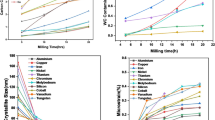Abstract
FINE grinding of graphite is usually carried out in a mortar or in a ball mill. The reduction of the particle size proceeds rather slowly due to the lubricating action of the grain surfaces, and the ground crystals contain various kinds of lattice imperfections including stacking faults—the extent of the imperfections being subject to the period and method of grinding. Recently, Bacon1 and others2–5 studied this phenomenon, both using an electron microscope and X-rays. I myself carried out some experiments on similar lines with Madagascar graphite ground in a cell excited with ultrasonic waves. The original powder was 50–65 mesh graphite crushed in a mortar. The slurry containing the powder was treated with 20-kc/s, 150 V amp ultrasonic radiation in a cylindrical cell 26 mm in diameter. The slurry entered the cell through a pipe attached on the face of the cylinder and flowed out through another pipe attached on the opposite side, and it was circulated slowly with a gear pump. The ultrasonic power was supplied through the top of the cell which was the end plane of the oscillator horn. The height of the cell was adjustable. In the range of height from 1 to 10 mm the change of grinding speed was not marked. The following media were used: Pure water, 1 per cent aqueous solution of tannic acid or detergent, glycerine, paraffin oil and dense bromoform (specific gravity 2.8). The bromoform seemed to have superior grinding powers, but was troublesome in extended use due to its corrosiveness and irritating vapour. The glycerine was found to be unsuitable for the purpose. Aqueous solution of tannic acid or detergent wetted the graphite particles, and the powder was uniformly dispersed after several passes through the cell. Crushing then proceeded continuously, although pure water did not wet it and the agglomerated powder floated on it for a long time without becoming dispersed in it. When ultrasonic vibration was applied in an open cell containing the slurry, for example by simply inserting the horn end in a beaker, the graphite particles were expelled from the horn and floated on the liquor surface even in water containing tannic acid or detergent. Paraffin oil was inferior to the aqueous solutions.
Similar content being viewed by others
References
Bacon, G. E., Acta Cryst., 3, 320 (1950), 5, 392 (1952).
Boehm, H. P., and Hofmann, U., Z. anorg. allgem. Chem., 278, 58 (1955).
Walker, jun., P. L., and Seeley, S. B., Proc. Third Carbon Conf., 481 (Pergamon Press, 1959).
Matuyama, E., Nature, 198, 574 (1963).
Freise, E. J., and Kelly, A., Phil. Mag., 8, 1519 (1963).
Author information
Authors and Affiliations
Rights and permissions
About this article
Cite this article
MATUYAMA, E. Ultrasonic Grinding of Natural Graphite. Nature 207, 1189–1190 (1965). https://doi.org/10.1038/2071189a0
Published:
Issue Date:
DOI: https://doi.org/10.1038/2071189a0
- Springer Nature Limited





